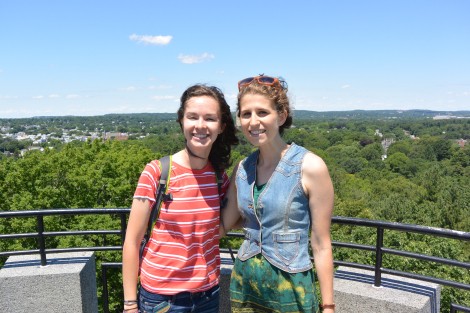SEEKING THE BOSTON-RURAL AT MOUNT AUBURN
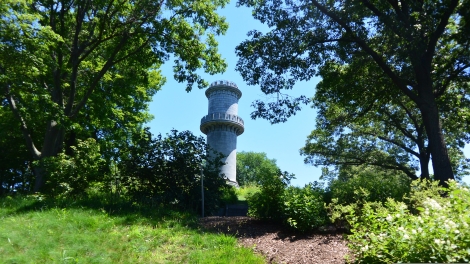
View up to Washington Tower on a sunny day in late-June.
Since the last blog post, the world of mapping has opened a portal into the Olmsted Center and swallowed me up! (Or, at least that’s what it feels like.) Tim Layton hosted a three-day mapping workshop last week, which provided instructions and demonstrations on valuable techniques, office standards, and data insertion on a both ESRI’s ArcMap and AutoCAD Map applications. Although, I already had a good grasp on both programs, Tim taught me some shortcuts and methods I hadn’t known before.
The sun decided to make a glorious appearance over the weekend following the workshop. Clare and I decided to do some exploring within the Boston area. We met in Harvard Square – where everyone else in the world seemed to be converging – and set out for Mount Auburn Cemetery.
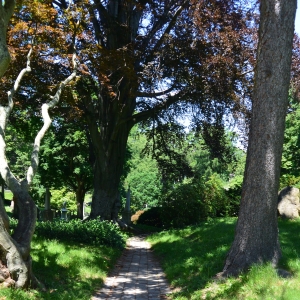
A picturesque scene along one of the trails, looking towards a grand beech.
Mount Auburn Cemetery is the nation’s (acclaimed) first rural cemetery. Today’s burial grounds and cemeteries take a variety of forms and conditions – graveyards, church yards, pastoral settings, urban crypts; you name it – but back in the early 19th-Century that was not the case. Before Mount Auburn, burials took place on private, confined plots, and usually associated with an adjacent church. After traveling through Europe, Dr. Jacob Bigelow found himself inspired to bring a garden cemetery to Boston. He sought to replicate a pastoral, picturesque English landscape in the hills just 4 miles from Boston’s center. After buying 70 acres of farmland, he brought on the founder of the Massachusetts Horticultural Society, General Henry A. S. Dearborn, to design the cemetery’s plant collections and garden layout. Groves, meadows, sculptures, trails, and flowering ornamentals transformed the rural landscape into a true garden.
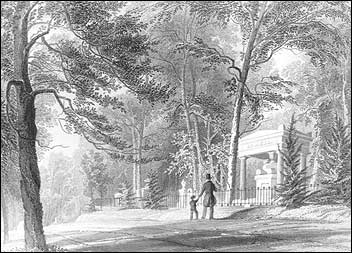
(From James Smillie’s Mount Auburn Illustrated in Finely Drawn Line Engravings. Courtesy Mount Auburn Cemetery)
Clare and I explored the grounds whimsically and only referring to the map at rare occasion. Thousands (nearly millions) of people have toured these grounds; however, I was thankful that I, unlike 19th-Century female visitors, could forgo a stuffy dress. (We saw photographs in the museum of Mount Auburn during the 1850s; a sure example of the juxtaposition between the day-and-age and how far lifestyles have changed.)
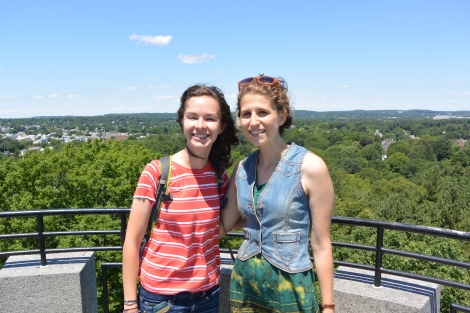
Spectacular view from Washington Tower.
Preservation at Mount Auburn faces an incredible amount of insight and adaptation. The most prominent features are the trees and herbaceous specimens; and they, being alive, require nurturing rather than ‘preserving.’ What stewards of the ground seek to preserve, instead, is the moments, botanical significance and ordering, and the view-sheds composed across the landscape. Washington Tower, a beautiful granite pinnacle in the center of the cemetery, provides 360-degree views from above the treetops, and is an example of the awe-worthy moments one will find in Mount Auburn.

We stopped often to admire the cemetery’s trees…and to enjoy their shade. This linden is absolutely breath-taking!
My favorite aspect of Mount Auburn Cemetery remains the phenomenal silvic collection within the garden. I found myself dashing across graves (always accidentally) to see the tags identifying each of the specimens. Although a little rusty on plant nomenclature, I was surprised in how many I recognized. Often I exclaimed at the trees size, form, or rarity. As a tree-lover, Mount Auburn was an absolute delight to discover.
My next task at hand, as we enter into July, is to complete an existing conditions map of the Baker-Biddle site by compiling ortho-imagery, field notes, and photographs from the site. Until next time!
